| Lot |
Photo |
Description |
Realized |
Lot 755 |
 |
Huge Five Inch Long Carcharodontosaurus Dinosaur Foot Claw. Carcharodontosaurus was a huge theropod (meat-eating dinosaur), perhaps even larger than a T-Rex. This massive and heavy five-inch-long foot claw is a light brown color with an excellent, not distorted, shape and no restoration except for the usual crack filling. This large, impressive foot claw is 80 million years old from the Tegana Formation of the Kem-Kem basin of Morocco, North Africa. Dinosaur claws are much rarer than dinosaur teeth because dinosaurs replaced their shed teeth but did not replace their claws; they are only recovered where the dinosaur died and was buried. This claw is much larger than those usually found. Estimated Value $2,000 - UP
View details and enlarged photo
Realized
$1,508 |
|
Lot 756 |
 |
Large 3.5 Inch Albertosaurus Theropod Dinosaur Tooth. Albertosaurus was a somewhat smaller version of its more famous relative T-Rex growing to just over 30 feet long. Albertosaurus may be a direct ancestor of T-Rex. Unlike T-Rex, Albertosaurus had two short bony crests above its eyes and was also older than T-Rex at 70 million years old. It is found only in the Judith River Formation of Montana and Canada. This large 3.5 inch brown tooth, which was found on a private ranch in Montana, is one of the largest for the species. It is very colorful, complete and original with some serrations. This tooth has no restoration and is very large for an Albertosaurus. A T-Rex tooth of this size would sell for more than $7500. Estimated Value $1,500 - UP
View details and enlarged photo
Realized
$1,080 |
|
Lot 757 |
 |
Huge 3.5 Inch Camarasaurus Tooth With Root. Camarasaurus was a huge saurapod, plant-eating dinosaur that lived 150 million years ago in the Morrison Formation of Colorado. Camarasaurus, meaning "chambered lizard" (referring to the hollow chamber in its vertebrae) lived alongside other more-famous saurapod behemoths such as Diplodicus and Apatosaurus (Brontosaurus). This huge Camarasaurus tooth is 3.5 inches long, consisting of a 1.7 inch enameled tooth and a 1.8 inch, mostly-complete root. Most teeth of dinosaurs are found without their root because they were lost while the dinosaur was still alive; rooted teeth would only be lost when the dinosaur died. Camarosaurus has a larger and sturdier skull than the Diplodicids and its teeth were much larger and of a totally different shape. This Camarosaurus tooth is shaped like a chisel, unlike the slender pencil shaped teeth of the Diplodicids. The shape of its teeth indicates that Camarasaurus ate different types of vegetation from the other saurapods, most likely coarser plants that grew closer to the ground. Saurapod teeth are much rarer than theropod teeth because they did not lose their teeth biting into other animals flesh and bone. This large and rare tooth is in an 8 x 6 inch Riker mount. Estimated Value $1,250 - UP
View details and enlarged photo
Unsold |
|
Lot 758 |
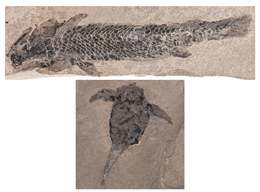 |
Two Different Species of Devonian Fish from the Old Red Sandstone Formation of Scotland. This remarkable 18 x 6 inch black stone matrix is 380 million years old, from the Old Red Sandstone Formation of Scotland. There are two very different species of fish on this plate. There is a 7 inch long Osteolepis, which was a lobe-finned fish that had scales and plates on its head covered in a bony material called cosmine. It was a rhipidistan that had many features in common with the very first tetrapods that crawled onto the land. The second fish is a 2½ inch Pterichthyodes, a genus of antiarch placoderm that had a heavily-armored head and upper body with strange wing-like appendages. These very primitive fish look very different from the fish in our oceans today. Estimated Value $1,000 - UP
View details and enlarged photo
Realized
$600 |
|
Lot 759 |
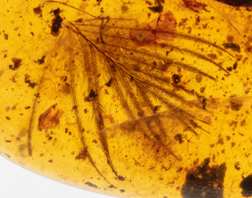 |
Possible Dinosaur Feather in Amber. Most amber is too young to have dinosaur feathers in it, but Burmite is the name for 100 million year old amber found in the Hukawang Valley in northern Burma (Myanmar). It was one of the science stories of the year a couple of years ago when dinosaur feathers were found in 80 million year old Canadian amber. These feathers could belong to an early bird or theropod dinosaur because what defines a dinosaur and an early bird is somewhat blurred. From remarkable fossils found in China, both Coelerasaurs and Tyrannosaurs are known to have been feathered. Both the quality and diversity of dinosaur feathers found in Burmite is superior to the Canadian amber. This 6 mm clear partial feather is beautifully preserved in an 18 x 13mm polished cabochon of honey-colored amber. The branching feather has excellent detail and is symmetric on both sides of the central rachis, which means that it is not a flight feather but rather a body, tail or neck feather. This very rare, possible dinosaur feather is presented with a color photo in an 8 x 6 inch Riker mount. Estimated Value $1,000 - UP
View details and enlarged photo
Unsold |
|
Lot 760 |
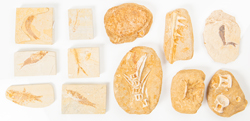 |
12-piece Fossil Collection. Fish fossils and related invertebrates from the Green River Formation. These fossils cover the late Cretaceous through the Paleocene periods, 80 to 55 million years ago. Each fossil is embedded in limestone and range in size from 3" to 6" with a thickness of ¼" to 2".
condition and each fossil is suitable for framing or as a stand alone piece. Estimated Value $800 - UP
From the Living Torah Museum, Brooklyn, New York.
View details and enlarged photo
Unsold |
|
Lot 761 |
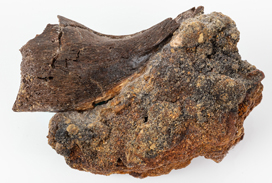 |
Two Inch Long T-Rex Hand Claw in Original Matrix. This rare two inch Long dark brown T-Rex Hand Claw is still embedded in its original limestone matrix as found over 20 years ago on a private ranch In the Hell Creek Formation of Montana. The claw is complete with a cracked tip missing just a small portion of its backside on the matrix. Claws from a T-Rex are much rarer than T-Rex teeth because T-Rex only had two claws on each its small hands but continually replaced lost teeth. Estimated Value $800 - UP
View details and enlarged photo
Realized
$461 |
|
Lot 762 |
 |
Fossil Badlands Turtle With Bite Marks. Stylemys nebrascensis was a 30 million year old turtle that roamed the White River Formation of the Badlands of Pennington County South Dakota. This 7X6 inch turtle is unusual in having two deep bite marks that pass through the shell. They definitely look like the bite marks from two large canine teeth possibly made by a Hyaeodon as the teeth of a saber tooth cat were not strong enough to penetrate the hard shell without breaking. The outer carapace is remarkably complete with the individual scutes being a lovely blue- gray color. Also several of the ribs show through the lower scutes with one protruding through the plastron. Stylemys' carapace was formed by a series of scutes made of keratin originally. Keratin is the same material that our finger nails are made of. About 90 percent of the underside of the turtle, the plastron, which was formed by bony plates is preserved. This turtle is of museum quality with the highly desirable predator bite marks. Estimated Value $750 - UP
View details and enlarged photo
Realized
$480 |
|
Lot 763 |
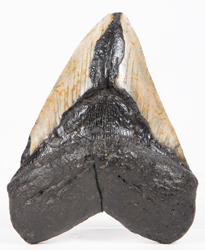 |
Carcharodon Megalodon Shark's Tooth, A Large 6" Specimen Boasting Unusual Coloring with Almost All Enamel Intact. Teeth from the Carcharodon megalodon, the largest shark that ever lived, are in great demand especially teeth that are large -- 6" in length. This exceptional specimen is 15 million years old and was found in the muddy river waters of South Carolina. In estimating the length of the shark based on the size of tooth, this behemoth would have been 60 feet long. This fine specimen has near complete enamel on both the front and back except for the center section strip (common) on front side. But it is the color that makes this tooth special, being taupe with some flecks of orange on the front enamel. A fine addition to any collection for every level of collector. Perfect holiday gift giving. Estimated Value $600 - UP
View details and enlarged photo
Realized
$357 |
|
Lot 764 |
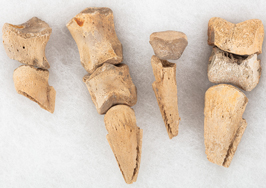 |
Partial Thescelosaurus Dinosaur Foot with Four Claws and Six Toe Phalanges. This partial foot belongs to an 8 to 13 foot long herbivorous dinosaur that weighed between 450-650 pounds named Thescelosaurus. Thescelosaurus was one of the very last dinosaurs alive at the end of the Cretaceous period. It was bipedal with a four toed foot. What makes this lot interesting is that all of the bones were found in the same dig in the 67 million year old Hell Creek Formation of Montana and belong to the same dinosaur, not a composite. The partial foot consists of parts of all four claws and six of the toe phalanges. All four claws would be about one inch long with two of the claws virtually complete except for the ends of the tips and the other two being partials. One toe is four inches long and complete with the best claw and three complete phalanges. The other three phalanges are partial. Thescelosaurus was a hypsilophodont dinosaur famous for the excellently-preserved specimen found in 1993 in South Dakota with a well-preserved heart. Preserved in a 8 x 6.5 inch Riker Mount. Estimated Value $600 - UP
View details and enlarged photo
Unsold |
|
Lot 765 |
 |
Museum Quality Sea Scorpion. Eurypterids, also known as sea scorpions, were fierce predators in the warm seas 425 million years ago. Some grew to over 6 feet long and easily hunted the slow-moving armored fish of that era. Eurypterids were related to scorpions and were probably the first animal to leave the sea and crawl out on dry land. This complete, highly detailed 4.25 inch sea scorpion, Eurypterus remipes, comes from the famous 425 million year old Fiddler's Green Quarry of Herkimer County, New York. This magnificent specimen is exceptionally rare in that it is complete with all six of the walking legs as well as the two paddles, which are preserved with excellent detail, along with an excellent head, body and telson (looks like the stinger in a scorpion but was not poisonous). The walking legs have amazing detail with the first two pairs of legs having feather-like ends that were used to sense prey. This Eurypterid is preserved in its underside (ventral position) that also enables some detail of its mouth as well. This is the very best quality for a sea scorpion; fewer than one in a hundred comes close to the quality of this specimen, which is nicely centered on a 6.5 x 4.25 hard gray matrix. Estimated Value $600 - UP
View details and enlarged photo
Realized
$360 |
|
Lot 766 |
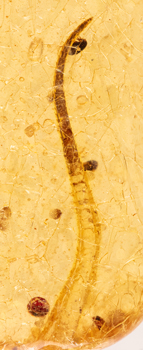 |
Lizard Tail With Blood Droplets In Madagascar Copal. Although insects are common in amber or copal, larger creatures such as lizards are rarely encountered because they are much bigger and can just walk away out of the gooey tree resin. Copal is just young amber that has not had time to harden. This rare and spectacular .75 inch fossilized Lizard tail with four fossilized blood droplets is contained within a 1.75 inch clear, fully-polished cabochon of two million year old Madagascar copal. This fossil tells a story of a small lizard being trapped in tree resin and then shedding his tail to free himself and in this act leaving four blood droplets which still remain fossilized in this extraordinary specimen. Beautifully preserved with excellent scales and brown color markings, with bright red blood droplets. Both lizard and blood are extremely rare in copal or amber. Complete small lizards have sold for more than $50,000 in amber. Presented in an 8 x 6 inch Riker mount. Estimated Value $600 - UP
View details and enlarged photo
Unsold |
|
Lot 767 |
 |
Agatized Dinosaur Tail Vertebrae Bone. Agatized dinosaur bone occurs when the hollow bone structure of the dinosaur is replaced by quartz and trace minerals such as iron over millions of years. The best quality agatized dinosaur bone comes from the Jurassic era in Utah, from the 150 million year old Morrison Formation. The vast majority of the dinosaur bone found is just broken fragments; rarely is an identifiable bone found such as this 5 x 4 x 6 inch sauropod tail vertebrae. The tail vertebrae are pretty much complete except for the neural spine process. Only the top of this rare dinosaur bone has been polished to reveal the bone structure. The individual cells in the center of the bone are distinct and range in color from white calcite to many shades of brown, all the way up to orange. This impressive fossil stands on its own on the backside of the vertebrae. Estimated Value $600 - UP
View details and enlarged photo
Realized
$390 |
|
Lot 768 |
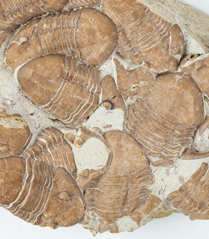 |
Death Assemblage of More Than a Dozen Homotelus Trilobites. Trilobites are usually found as individuals, witha grouping of trilobites being quite rare. This 7.5 x 5.5 inch block contains more than a dozen complete and partial Homotelus bromidensis trilobites from Criner Hills, Carter County, Oklahoma. These light brown 3-D trilobites are nicely contrasted on a yellow-colored stone matrix. This assemblage is either a death assemblage or perhaps a molting when groups of trilobites gathered to molt their hard shells and mate. Estimated Value $600 - UP
View details and enlarged photo
Realized
$523 |
|
Lot 769 |
 |
Tarantula Dipluridae and Other Insects in 100 Million Year Old Burmite Amber. Burmite is the early Cretaceous 96-110 million year old amber found in the Huzanne Valley in northern Myanmar (Burma). The tarantula is 5½ mm long with an odd looking beetle and centipede in a 25 X 17 X 9 mm honey colored amber nugget. Tarantula Dipluridae are known as Funner-Web Tarantulas having large and powerful chelicerates (fangs) that are venomous and move up and down in a stabbing motion. The venom gland is contained within the fangs. This rare extinct spider is presented with an enlarged photo in a 8X6 inch Ryker mount. Estimated Value $600 - UP
View details and enlarged photo
Unsold |
|
Lot 770 |
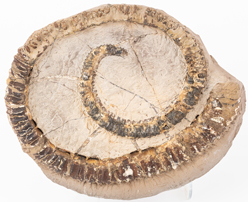 |
Rare Large Aegerocioceras Aberrant Ammonite From Germany. Ammonites looked like squid in a shell and became extinct along with the dinosaurs 65 million years ago. This large 8 X 6½" aberrant ammonite is 100 million years old from Germany. It is contained a hard stone concretion that when it was cracked in half revealed this spectacular uncoiled ammonite. Aberrant ammonites began to uncoil from the usual coiled ammonite shape from some unknown reason in the Cretaceous. This virtually complete dark brown uncoiled trilobite is rare and interesting. Estimated Value $600 - UP
View details and enlarged photo
Unsold |
|
Lot 771 |
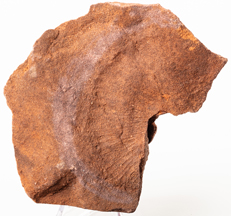 |
Rare Pre-Cambrian Large Partial Dickinsonia costata Preserved in Quartzite. One of the most important enigmatic animals of the Pre-Cambrian fossils of South Australia is Dickinsonia costata. Preserved in the 560 million year old red Quartzite in the Flinders Range, about half of this rare and important fossil that is quite large at 4 x 3" on a 5½ x 4" red Quartzite matrix. Dickensonia was an ovoid, segmented animal without eyes or a mouth that lived on the ocean floor that fed on algae blooms and was able to move over the algae fields in feeding. It was one of the very first animals that was capable of movement. There is still much debate as to what it was and what it is related to in the modern oceans, everything from some kind of flat worm to some strange quilt-like animal that has no descendants. Estimated Value $600 - UP
View details and enlarged photo
Unsold |
|
Lot 772 |
 |
Complete T-Rex Juvenile Tooth Two Inches Long. This complete T-Rex tooth is 2 inches long with good serrations that are almost complete. All T-Rex teeth are shed teeth except the very few that are found with the root still attached. This impressive and rare tooth has lovely light brown color with no restoration and just some minor crack filling. It was found in an ancient river or lake bed on a private ranch in the 65-67 million year old Hell Creek Formation of Powder River County, Montana. All T-Rex teeth are in great demand, but those very few that are not broken and repaired are rarely encountered. Estimated Value $500 - UP
View details and enlarged photo
Realized
$432 |
|
Lot 773 |
 |
Partial Plioplatecarpus ictericus Mosasaur Jaw With Nine Teeth. Mosasaurs were the T-Rex of the Cretaceous seas. This excellent 6¾ inch partial jaw of Plioplatecarpus ictericus is 70 million years old and was found in Fall River County, South Dakota. It has nine sharp conical teeth. Mosasaurs were the apex predators of the late Cretaceous seas and fed on fish, squid and ammonites. Plioplatecarpus ictericus was discovered and named in 1871 by Othniel Marsh during the Yale expedition along the banks of the Smoky Hill River. Estimated Value $500 - UP
View details and enlarged photo
Unsold |
|
Lot 774 |
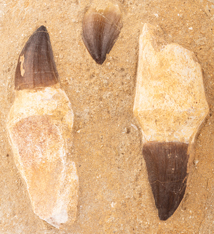 |
Three Large Mosasaur Teeth in Matrix. Mosasaurs were the T-Rex of the late Cretaceous oceans, being the top predator. They were huge marine reptiles 40-60 feet long and related to lizards and snakes. This 7¾ X 7 inch sandstone matrix contains three large Mosasaur teeth. The largest two teeth are 4 ¼ inches long, including their original root, with the third tooth at 1¼ inch long with no root. All the teeth have lovely brown enamel teeth contrasting with the tan colored original roots. These Mosasaur teeth are 70 million years old from Khourigba, Morroco. Estimated Value $400 - UP
View details and enlarged photo
Unsold |
|
Lot 775 |
 |
Carcharodontosaurus Dinosaur Tooth With Partial Root. Large 2.3 inch tooth with a partial root of Carcharodontosaurus saharicus, the T-Rex of Africa. Carcharodontosaurus was as large or even larger than a T-Rex. This light brown tooth has very good enamel and good steak-knife-like serrations on both edges of the tooth. All dinosaur teeth with their original roots are rare as this means that the dinosaur tooth came from a skeleton of an actual dinosaur and not a shed tooth. More than 99% of all found theropod dinosaur teeth are shed teeth. This impressive tooth with no restoration was found in the Sahara desert of Morocco. Carcharodontosaurus was older than a T-Rex at 70-80 million years old. Carcharodontosaurus teeth are much thinner than T-Rex teeth and were excellent for cutting through flesh, whereas the much thicker T-Rex teeth could easily bite through bone. Estimated Value $400 - UP
View details and enlarged photo
Realized
$234 |
|